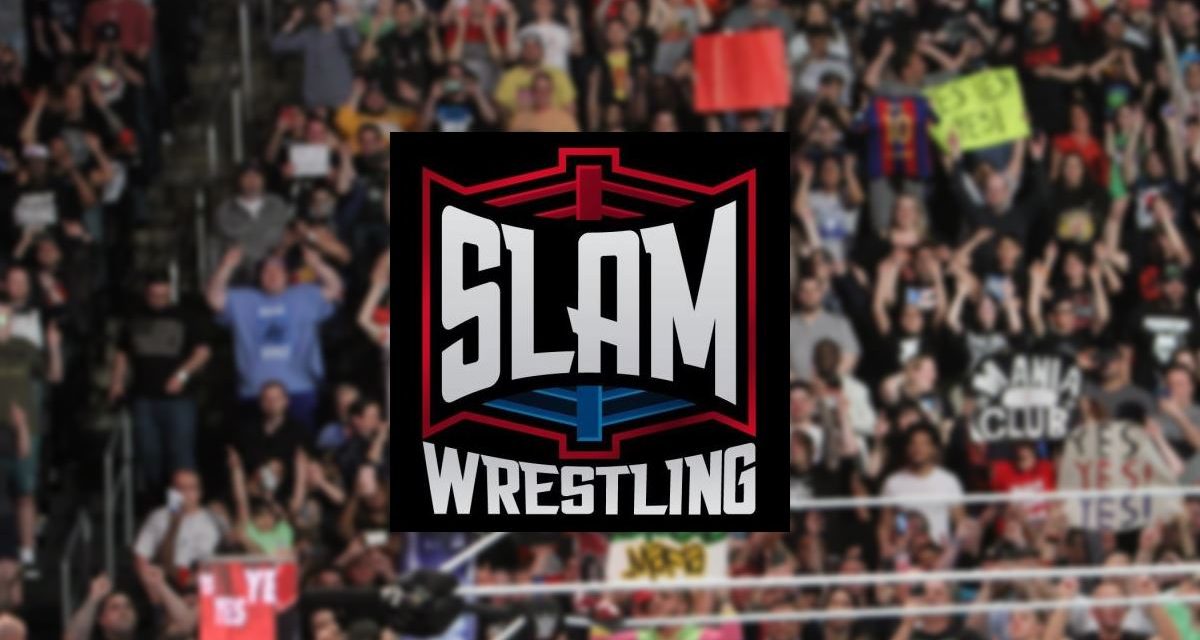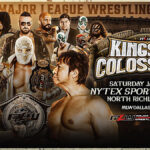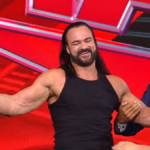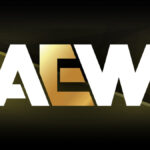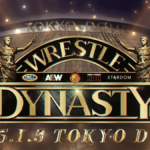At just a few months shy of 68 years of age, one of England’s most cherished professional wrestling talents finally made his way to the United States in late March, as Johnny Saint teamed with Mike Quackenbush and Jorge Rivera for CHIKARA’s King of Trios tournament in Philadelphia.
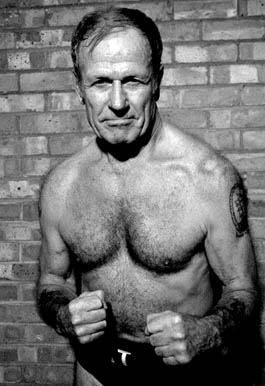
Johnny Saint
Although ultimately unsuccessful — going out in the tournament to Claudio Castagnoli, Dave Taylor, and modern-day technical virtuoso Bryan Danielson — he did, in fact, accomplished his true goal, in winning over the North American audience with the style that he describes as a type of “escapology.”
“I’ve been an admirer and fan of Johnny Saint’s style for the last 13 years, and it’s been a privilege to wrestle him in Europe,” CHIKARA co-founder Mike Quackenbush told SLAM! Wrestling a few days before the March 27-29th shows. “It will be an honour to team with him here in the United States at King of Trios, and I think the American wrestling audience will be in for a real treat when they see the elegant, no-nonsense style that Saint has to offer. To me, he embodies the best of British wrestling.”
The 1983 book, Sportsviewers Guide Wrestling by Peter Bills, David & Charles, confirms Quackenbush’s belief. “Saint is probably the greatest tactician around today. He has devised a bewildering selection of counters and offensive moves over the years. He prefers skilled exchanges of hold and counter wrestling, but can dish it out with the roughest when the occasion demands.”
In conversation, however, Saint is hardly a braggart. “I can’t begin to describe the sense of pride I had to be there, and to be treated as welcomingly as I was,” said Saint following his return to England. “At my age, I never thought I’d get a second bite at the apple (a return to wrestling), especially in the United States. What astonished me was that everywhere I went, among the fans and among the wrestlers, everyone seemed to know me, and my style of wrestling. If you didn’t have your feet on the ground, you could get a bit conceited about it!
“I’m just so pleased that the crowd took to my style like they did,” he continued. “They were chanting ‘This is wrestling! This is wrestling!’ when I was in the ring — they seemed to love every move. I can only imagine it’s because they haven’t seen that style performed live before. It was just amazing to me.”
Born in Failsworth in Manchester in 1942, Saint started off his athletic life in track and field, but also in amateur boxing. Never really interested in academics, he threw himself into the sports that he had a more natural ability for, and it was during his boxing training that he first discovered the art of wrestling, much of it taught to him by the notorious catch wrestler, Billy Robinson.
“I had never seen wrestling, and I had never been to a live event until I met Billy,” noted Saint. “I was always an amateur boxer. When I met Billy, both his dad and his uncle were professional boxers, and when the family opened a gymnasium in Failsworth, I went there and his dad passed on some of that boxing knowledge to me.
“Billy could be one mean the son of a bitch back then (laughs). When I met Billy, I had just left school, so I would say I was about 16. I was, at the most, 11 stone (154 pounds) wet-through, while Billy was 15 stone and in good condition. I used to spar with him, but rather than just box, we would wrestle as well. I always came off the worse with him — there were lots of wrestlers that came off worse with him! (laughs).
“So Billy taught me catch wrestling. I quite liked it, and slowly it began to take over boxing for me. I guess I just sort of took to it — I was adaptable. The thing was also that they were far more wrestlers in the gymnasium and there were boxers, so it was easier to find someone to wrestle with than it was to find someone to spar with.”
Saint — who was born John Miller, and eventually took the surname from the popular Roger Moore TV show The Saint — continued to train in much the same manner for the next two years, a regime that was only changed when he was told, much to his surprise, that he would be training at a different venue one evening. It was there that he was introduced to the world of professional wrestling, although Robinson wasn’t exactly forthcoming with all of the important details.
“I remember being put in the ring that night with a few different guys, but what I didn’t realize that was that the people who were standing around watching were promoters. When I came out of the ring, some of them asked me if I’d like to turn professional. The told me that they could give me some work, and so I ended up having my first professional match on May 18, 1958 (against Colin MacDonald), which was my 18th birthday.
“Before going to the gym that night, I had no aspirations to be a professional at all. When they said that they would give me some matches as a professional, it was like a bombshell to me. I didn’t even know that they were promoters, never mind knowing what they were doing there that night. It was like a bolt out of the blue.
“Jimmy Lewis, Grant Fotheringham, Danny Flynn, and Fred Wooley (well known British promoters of the day) were all there, and were actually still wrestling on the scene at the time. What’s funny is that, even then, Billy never let me in on the tricks of wrestling (that outcomes were predetermined) — it was other people that did that. In the world that Billy showed me, wrestling was 100 per cent straight all the time.”
Working in the north of England was very lucrative for Saint — especially considering the factory work with which he had previously made his living — but it was even more so when he traveled further south towards London, which was all new territory for him. The biggest wrestlers in the British industry, like Mike Marino and Jackie Pallo, were working in the capital for Dale Martin Promotions, but while the opportunity to work with those household names was a great boon for Saint’s career, the Joint Promotions alliance was what really began to give him some momentum.
“In old money, we used to get £3.00 and 10 shillings ($6.33CAD) for working at the men’s clubs in Manchester. That was for six five-minute rounds, which was good money indeed. We could go to places like the Old Chester Drill Hall, or the Oswestry Baths on a Saturday night, fairly regularly throughout the year, and I could get £5 for the same. At the same time, I used to work in a factory from 7.30 a.m. to 5.30 p.m., and I would get about £9.00 per week. So it was incredible to get paid that much for something I enjoyed doing.
“I remember getting a phone call one day saying that they were a man short in London. I think the call was from Danny Flynn. They wanted me to come down on the train to London and work for Paul Lincoln, who was running cinemas at the time, and where I’d get £8 for the one bout, plus the train fare, which really was amazing. By that time, I was already wrestling full-time, and I must have been about 21. There were a few ups and downs, but I was convinced that that was what I wanted to do.
“But I have to say, there weren’t a lot of opportunities, and it was a very hard business to be in, and sometimes a dodgy one. I was working for the small independent promoters, and they had not yet begun to work together by that time. So you might get a promoter who would offer you five or six jobs in one month, and then another who would offer you same, and if any of the jobs were on the same night, you’d have to make a choice between one and the other, and you could easily fall out with people. You were always between the devil and the deep blue sea, and it was the wrestlers who invariably lost out. It wasn’t until I went to Joint Promotions in the late ’60s that I really began to have a good career, because the promoters were finally working together. Then, I was on television, and to me, it’s was like the small-time amateur boxer finally made it big.”
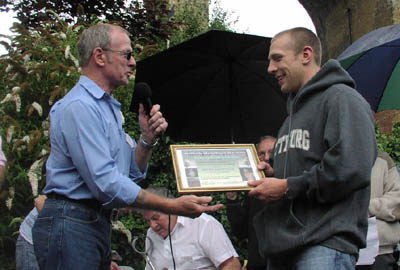
Johnny Saint presents an award to Bryan Danielson at the 2006 UK Wrestlers Reunion. Courtesy www.britishwrestlersreunion.co.uk.
As the ’60s transitioned into the ’70s and ’80s, Saint saw a lot of changes in the British wrestling scene. The tough guys of the ’60s — schooled initially in Olympic or catch wrestling — were becoming a rare breed, and the flamboyant types were becoming the biggest stars. But Saint wasn’t ready to change his unique mat-trickery dramatically, thinking that it still had a place in the ever-evolving game.
“Between the ’60s and ’70s, the promoters were adding more and more of a flamboyant style as opposed to straight, clean-cut wrestling. A little like Adrian Street, I suppose — and it was a great way to get a reaction. — I give credit to these guys who had the nerve to do that, which I never had.
“But that doesn’t mean that there weren’t great wrestlers around, too. Jim Breaks was fantastic, and we were just naturals for one another. He was fabulous amateur psychologist — he could make people mad at him without doing anything! Mark Rocco was also a great wrestler. He was a big, heavy lad actually. I think he had watched some American wrestling, and really combined both styles into a good mix. He was all go, and had some flamboyance about him as well. And with The Dynamite Kid, it was obvious from the first moment that I saw him that he was going to go places. Not only was he a great wrestler, who worked very, very hard, but he had a ruthless ambition to get where he wanted to go.
“But even though things were clearly changing (by the early 1980s), my style was always my style, and I never thought that the business would change as much as it did. I think my style ended up being a little out-moded. The showmanship was all in, which you saw with Big Daddy. I think I ended up like a time machine for the business, to make up the timing for cards, and maybe to put wrestling work in.”
Unfortunately, the times were a-changing not only in wrestling, but in television as well. ITV (Independent Television, the second most-watched British TV station, behind BBC1) chief Greg Dyke cancelled the World of Sport TV show, and British Wrestling, in 1988, after initially moving Big Daddy et al away from their traditional time-slot of 4 p.m. on a Saturday, when viewers would watch in their millions before the soccer results were rounded up at 4.45 p.m. Dyke believed that there was no advertising money to be made from wrestling, nor did it fit with the modern image he wanted for ITV, and his decision quickly made him the most hated man among wrestlers and fans alike. Saint, and many of his peers, now either had to look abroad for work, or retire from the industry completely.
“When it all happened, to be honest, I was surprised to find out that Greg Dyke had so much sway at ITV. It was a terrible jump from lots of wrestling on TV, to nothing at all, and I started wrestling abroad a lot more. I wrestled in France, Belgium, Germany, and places like that. I also went to Africa several times.
“I think we were still giving a good product when World of Sport was pulled off the air. I don’t know what went wrong. I know that Greg Dyke played a big role in it, but for what reason I don’t know. It was an institution, and you wonder what he was thinking, given that it was so popular. We’re talking about a TV program that went back to the 1950s, but it was gone almost in an instant.
“Wrestling had basically done a 180. It had come off television and it just wasn’t the same anymore. And also, there weren’t so many good guys to work with. There was a mass exodus of people in the business, and there just wasn’t the talent. The golden generation had pretty much all gone by that time. I remember doing a few jobs and traveling on my own to places, and there were some nights when I was driving back over the Moors (in Yorkshire) that I felt like a dinosaur. I’d been in the business that long, that I had that strange feeling. So I was always in business, and so I had holiday apartments in Blackpool and things like that, so in the end I just concentrated on that business instead of wrestling.”
Saint officially retired in 1999, but in reality, only took a limited number of bookings in the ’90s. Those, however, included a tour of Japan with Michinoku Pro in 1996, when he competed against opponents like Naohiro Hoshikawa and Masato Yakushiji. After his retirement in 1999, Saint never envisaged wrestling again, but was finally lured back into the ring, after training some younger wrestlers in his particular brand of wrestling.
“I’d never really thought much about training younger wrestlers, but various people got in touch with me and asked me if I’d do it. First of all, they asked if I’d consider coming out of retirement, and I said no to that, so they then asked if I’d agree to do some training sessions, which I was happier to do. Then, out of the blue, someone asked me to do a match, and it felt right to say yes. Now I’m doing matches and training sessions (laughs).
“Having names like Johnny Saint on our roster took a small company which ran around 20 shows per year, to a big company running about 100 shows per year,” said Sanjay Bagga, the promoter of LDN Wrestling. “In 2009, we expect to do 150 shows, doing the World of Sport-style that Johnny helped to make famous.
“Along with Kendo Nagasaki, Johnny Saint was basically the first name on my list when it came to having these guys involved. You can learn so much from Johnny in particular. People said to me, you’re going to ruin his reputation as one of the greatest ever technical workers if you put him on your show at this point in his life, but after his match, he got 7-8 minutes worth of a standing ovation. He proved that there’s no way that he’d lost his touch.”
“I don’t wrestle very often these days,” Saint picked up. “I did about 12 matches in 2008, which I find is about enough for me at the moment. It gives me enough time to get over the aches and pains, and to get some training in.
“The reason I’m doing this is because, even now, I’ve got to have an interest — I’ve got to have a goal. My favourite hobby is motorcycling, but when I do that, I can’t just jump on my bike and go for a ride. I have to have a place to go to — an end product, if you know what I mean? It might be somewhere as small as a little cafe, over a distance as long as two hours, but I’ve got to have that goal to reach for. It’s part of my make-up, and part of what makes me going.
“I’ve always liked to train, and keep myself supple and fit, but if you’re training without anything to achieve, you can get bored, so you need to be able to set your sights on something. For example, I’ll say to myself ‘I’ve got a match in five weeks, let’s work out a training routine and really get stuck into it.’ It’s an incentive to gee me on a little bit.”
In wrestling at 67 years of age, and in debuting in America in that same year, the story of Johnny Saint is a miraculous one. But Saint doesn’t believe that he’s done yet, and nor do the promoters that remain delighted to be able to work with him.
“When I brought him back the first time, it was for an adult audience who were probably there for a night of wrestling nostalgia,” said Bagga. “But then I used him back in his hometown in Wales, and it was a kids audience, and they loved it too. He has the ability to captivate the audience in a way that few other wrestlers can.”
“Philadelphia, dating back even before the days of the original ECW, has been home to some of the toughest, rudest, most difficult-to-impress fans you’ll find anywhere,” concluded Quackenbush. “And 99.9% of them in attendance at King of Trios were in utter awe of Johnny Saint — the most elegant counter-wrestler to ever lace up the boots. I’m sure John knows full well that he’ll always have a home in CHIKARA, whenever he chooses to return.”
